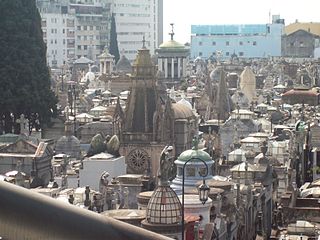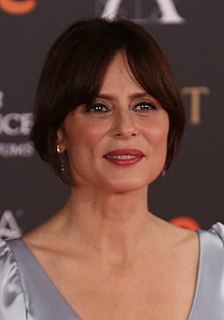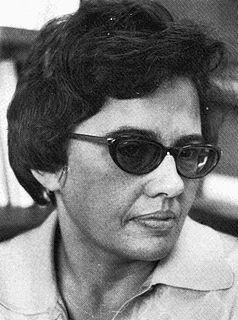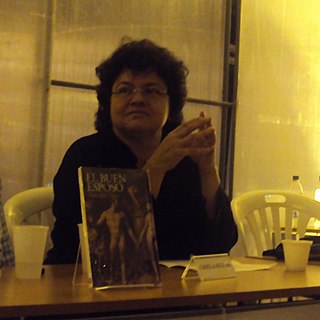
Pedro Gutiérrez de Valdivia or Valdiva was a Spanish conquistador and the first royal governor of Chile. After serving with the Spanish army in Italy and Flanders, he was sent to South America in 1534, where he served as lieutenant under Francisco Pizarro in Peru, acting as his second in command.

La Recoleta Cemetery is a cemetery located in the Recoleta neighbourhood of Buenos Aires, Argentina. It contains the graves of notable people, including Eva Perón, presidents of Argentina, Nobel Prize winners, the founder of the Argentine Navy, and military commanders like Julio Argentino Roca. In 2011, the BBC hailed it as one of the world's best cemeteries, and in 2013, CNN listed it among the 10 most beautiful cemeteries in the world.

Aitana Sánchez-Gijón de Angelis is a Spanish-Italian film actress.

Reinaldo Armas Enguaima, better known as Reynaldo Armas, is a Venezuelan llanero singer and composer.

Juan Calzadilla is a Venezuelan poet, painter, and art critic.

Adriano González León was a Venezuelan writer who is known in his country for the novel País Portátil (1968), widely regarded as the premier Venezuelan novel of the latter half of the 20th century, and for his many years of hosting a television program dedicated to promoting literary appreciation among the general public.
The National Prize for Literature is a literary award made annually to Venezuelan writers.

Luis Britto García is a Venezuelan writer, playwright and essayist. His fiction has been recognised twice with the Casa de Las Américas Prize, for his works Rajatabla (1970) and Abrapalabra (1979). In 2002 he was the winner of Venezuela's National Prize for Literature, given as a lifetime achievement award. In 2005 he was recognized with the Ezequiel Martínez Estrada honorary award of Casa de Las Américas. In May 2012 he was appointed by President Hugo Chávez to the Venezuelan Council of State, "the highest circle of advisers to the president" provided for in the Venezuelan Constitution.

Leonardo Garet is a Uruguayan writer, teacher, and member of the National Academy of Uruguay.

Teatro Caupolicán is a theatre and music venue located on the San Diego street in Santiago, Chile. It was opened in 1936. During its long history has hosted sporting, political, and cultural events. Currently is an important concert venue for popular Chilean and international artists, with a seating capacity of 4,500 and a total capacity of 5,400.

Lauro Ayestarán was a Uruguayan musicologist.

David Ramón Sánchez Palomares was a Venezuelan poet, born in Escuque. In 1975 received the National Prize for Literature; in 2006 the first Víctor Valera Mora International Prize for Poetry; and in 2010 the Ibero-America Award for Literature.

José Maria Cruxent was a professional archaeologist considered to be the "Father of Scientific Archaeology" in Venezuela. He was born in Barcelona, Catalonia, Spain. Cruxent is known for making significant contributions to understanding the cultural history of Venezuela from the Paleoindian period to the early Colonial period.

Marie-José Fauvelle Ripert, best known as Miyó Vestrini was a Venezuelan poet, journalist and scriptwriter.

Ángel Viñas Martín is a Spanish economist and historian. He has published many works dealing with the Spanish Civil War focusing on the war finance as well as the international relations aspects of the conflict.

Death in Berruecos is a 2018 Venezuelan police drama film created and directed by Caupolicán Ovalles. It is a Venezuelan co-production with Panama through the Ibermedia Program, the Centro Nacional Autónomo de Cinematografía, the Villa del Cine Foundation and SOMOS Films. It was filmed in different locations in countries such as Venezuela, Panama and Ecuador. The film is based on the murder of General Antonio José de Sucre, and revolves around the investigation of Captain Alejandro Godoy, who ten years after the murder of General Antonio José de Sucre, reopens the process of his death and finds that part of the previous file that has been destroyed. The film premiered in Venezuelan cinemas on 13 April 2018.
Events in the year 2021 in the Dominican Republic.

Keila Vall de la Ville is a Venezuelan author living in the United States. She is the author the 2016 novel Los días animales (2016) which received the International Latino Book Awards for Best Novel in 2018 and has been translated into English as The Animal Days (2021). Vall de la Ville's 2007 short story collection Ana no duerme (2007) was finalist in Venezuela's Concurso Nacional de Autores Inéditos. She has published the poetry book Viaje legado (2016), the short story collection Ana no duerme y otros cuentos (2016) and has edited the forthcoming anthology Between the Breath and the Abyss: Poetics on Beauty, a compilation of essays and poems by thirty-three contemporary poets on the subject of Beauty. Her fiction and non-fiction work is included in several anthologies. She collaborates with El Nacional's Papel Literario del Diario El Nacional, Viceversa Magazine and Prodavinci, among other digital media.

Gisela Kozak Rovero is a Venezuelan writer, essayist, teacher and researcher.

Our Lady of the Rosary is a 1650-1655 oil on canvas painting of Our Lady of the Rosary by Bartolomé Esteban Murillo, previously in the El Escorial Monastery and Palacio Real de Madrid and now in the Museo del Prado in Madrid.


















